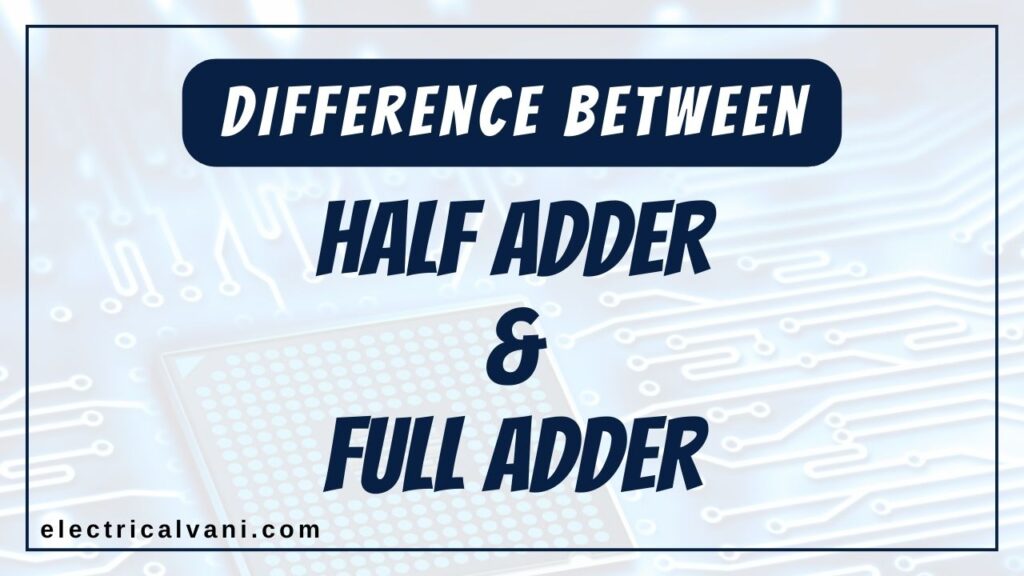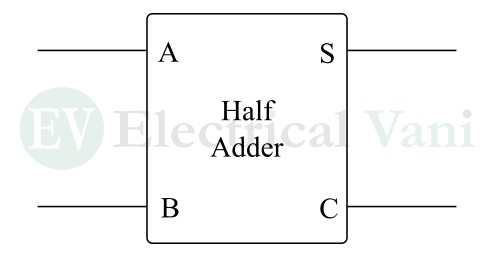In this article, I will explain the difference between half adder and full adder. In digital electronics, the adder, also called binary adder, is a digital system that can add two binary digits. Based on the number of bits that the adder can add, the adders can be classified into two main types namely, half-adder and full-adder.

A half-adder is a type of binary adder that adds two binary digits at a time and produces a sum bit and a carry bit (if applicable). The half-adder does not consider any previously generated carry while performing addition.
On the other hand, a full-adder is a type of binary adder that adds three bits at a time, where two are the input bits and the third one is the carry from the previous addition. It generates two outputs namely, sum bit and output carry.
Before going to learn the difference between half-adder and full-adder, let us first get an overview of half and full-adders in detail.
What is a Half-Adder?
The half-adder is a digital circuit that can add two binary digits at a time and produce two outputs namely, sum and carry.
The following figure shows the block diagram of a half-adder.

The half-adder is the most basic arithmetic electronic circuit used in various digital systems.
The important point to be noted about the half-adder is that it does not consider the carry generated in the previous addition, while doing the addition of input bits.
Truth Table of Half-Adder
The truth table of the half-adder shows the relationship between inputs and outputs and it is given below:
|
Inputs |
Outputs |
||
|
A |
B |
Sum (S) |
Carry (C) |
|
0 |
0 | 0 |
0 |
|
0 |
1 | 1 |
0 |
|
1 |
0 | 1 |
0 |
|
1 |
1 | 0 |
1 |
Logic Equations of Half-Adder
The logic equation for the sum (S) of the half adder is,
$$S=A⊕B$$
The logic equation for the carry (C) of the half-adder is,
$$C = A.B$$
Applications of Half-Adder
Half-adder is mainly used in the following applications:
- To design complex digital circuits
- To implement full-adder
- In arithmetic logic units (ALUs) used in computers and microcontrollers, etc.
Hence, this is all about half-adder and its related concepts. Let us now discuss the basics of full-adder.
What is a Full-Adder?
The full-adder is another type of binary adder used in digital systems like computers to perform binary addition of three input bits. Where the two are input bits and the third one is the carry from the previous addition.
The block diagram of the full adder is shown in the following figure.

Truth Table of Full-Adder
The truth table shows the relationship between the inputs and outputs of the full adder. The truth table of the full adder is given below:
|
Inputs |
Output | |||
| A | B | Cin | Sum (S) |
Carry (Cout) |
|
0 |
0 | 0 | 0 | 0 |
| 0 | 0 | 1 | 1 |
0 |
|
0 |
1 | 0 | 1 | 0 |
| 0 | 1 | 1 | 0 |
1 |
|
1 |
0 | 0 | 1 | 0 |
| 1 | 0 | 1 | 0 |
1 |
|
1 |
1 | 0 | 0 | 1 |
| 1 | 1 | 1 | 1 |
1 |
Logic Equations of Full-Adder
The logic equation for the sum (S) output of the full adder is,
$$S=A⊕B⊕C_{in}$$
The logic equation for the carry output of the full adder is,
$$C_{out}=AB+((A⊕B).C_{in})$$
Applications of Full-Adder
The full adders are mainly used in the following applications:
- In arithmetic logic units (ALUs) in computers and other digital systems
- To design parallel adder
- In binary counters
- In digital calculators
- In digital communication systems, etc.
This is all about full-adder. Till this section of the article, we have studied about the basics of half-adder and full-adder. Let us now discuss the differences between half-adder and full-adder.
Difference between Half-Adder and Full-Adder
The important differences between half-adder and full-adder are given in the following table:
| Parameter |
Half-Adder |
Full-Adder |
| Function | Half-adder adds two binary digits and produces two outputs, sum and carry. | Full-adder adds three binary digits, two input bits, and a previous carry and produces two outputs, the sum and carry. |
| Input terminals | Half-adder has two input terminals. | The full adder has three input terminals. |
| Carry propagation | Half-adder does not consider any previously generated carry while performing addition. | Full-adder considers the previous carry while doing addition. |
| Multi-bit addition | Half-adders cannot be directly cascaded to add multiple bits at a time. | Full adders can be cascaded to perform multi-bit addition. |
| Truth table combinations | The truth table of the half-adder has only four possible input and output combinations. | The truth table of the full adder has eight input and output combinations. |
| Logic gates | Half adder requires only XOR and AND gates for its implementation. | Full-adder requires XOR, AND, and OR gates for implementation. |
| Circuit complexity | Half adder circuit is less complex. | The full-adder circuit is relatively more complex than the half-adder. |
| Applications | Half-adders are used in simple digital circuits and to implement full-adders. | Full adders are used in complex digital systems like computers, calculators, communication systems, etc. |
Conclusion
In conclusion, the half-adder is a digital circuit that can add only two bits at a time, whereas the full-adder is a digital circuit that can add three bits at a time. Both types of adders are widely used in numerous digital systems. The primary function of both half and full adders is to perform binary addition. In this detailed article on the “difference between half-adder and full-adder”, I have explained the basic concept of half and full adders along with the key differences between them.